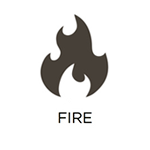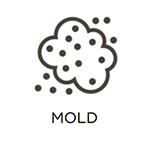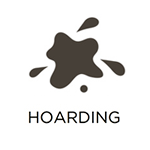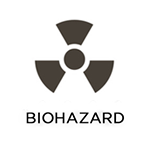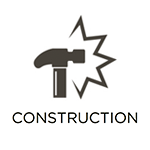ServiceMaster of Salem
[call](888) 915-7197[/call]
Water Damage Related Info
ServiceMaster of Salem would first like to thank you for choosing us as your emergency restoration provider for water damage. As we are proud to hold an excellent reputation, we work with compassion when providing our services. This may be your first major loss; however, our restoration technicians specialize in flood cleanup work as they have restored both commercial and residential properties for years. We have over 35 years of experience as well as training in the water damage cleanup industry. As we take our restoration services very seriously, ServiceMaster of Salem is dedicated in restoring peace of mind to both families and individuals. In regards to this, the information provided below is a list of procedures that may be required to restore your property to provide a safe environment again. In addition, a brief description of each procedure is also provided to allow for a better understanding of the specific service.
Of course, not all of the listed services will be required; however, we hope this checklist will allow for a better understanding in the restoration of your property. Your water damage restoration specialist can also explain the list in further detail if needed. You can also refer to our water damage FAQ section to answer any general questions regarding our services.
Preventing Additional Water Damage and Locating the Source
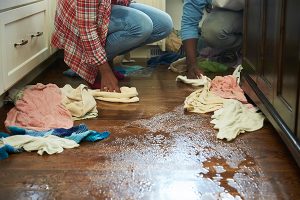 Upon arrival, your technician will first secure the affected areas and prevent the damage from spreading. You can also check out our page on how to prevent future water damage in order to avoid a major loss in the future. Following this procedure, he/she will identify the source of the damage by utilizing sensors, moisture-detection meters, and probes. A custom plan will then be developed in order to restore the area as quickly and effectively as possible. Just keep in mind that this procedure may require providing photographic evidence as well as locating possible insurance providers.
Upon arrival, your technician will first secure the affected areas and prevent the damage from spreading. You can also check out our page on how to prevent future water damage in order to avoid a major loss in the future. Following this procedure, he/she will identify the source of the damage by utilizing sensors, moisture-detection meters, and probes. A custom plan will then be developed in order to restore the area as quickly and effectively as possible. Just keep in mind that this procedure may require providing photographic evidence as well as locating possible insurance providers.
√ Inspect the attic. Framing, stored contents, and wet insulation will need to be treated, restored, or replaced.
√ Inspect the basement. As basements are one of the most common locations on a property to contain water, it will need to be inspected thoroughly for water damage.
√ Examine the duct work. The HVAC system will need to be inspected for any water seepage, including the ducts and air vents.
√ Inspect crawlspace. This area is also commonly known to contain water damage. If any damage is left untreated for a period of time, mold growth can occur. The insulation and framing may also need to be restored.
√ Protect household items. In addition to restoring your contents from water damage, ServiceMaster of Salem creates the proper conditions necessary for dehumidification. However, in some cases, the content restoration may need to be done at our facility as the property may contain too much damage for the procedure to be performed on-site.
√ Water Mitigation. The biggest step in water damage restoration is extracting the water from the affected area. This will ultimately accelerate the dehumidification process and minimize the moisture in the air. Our technicians use advanced tools, products, and equipment to efficiently restore all flooring layers. However, the restoration of each layer of flooring may happen at different times.
Carpet Examination
√ Carpet drying in place. If the carpet is not severely damaged, it can be left in place to dry.
√ Removal of the carpet and threshold covering from tack strip. Open seams. When the carpet has incurred significant damage, this procedure will allow for effective drying and prevent secondary damage.
√ Remove carpet padding. In order to prevent secondary damage, removing the padding is necessary. This will ultimately inhibit microbial growth and enhance the drying process.
√ Remove unsalvageable carpet. Sometimes the damage incurred in the carpet is too severe to be effectively restored. In this case, it would be more cost-efficient to order a replacement.
Inspection of Other Flooring Materials
√ 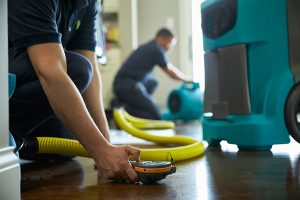 Tile: Dry in place or replace (It is more cost-effective to replace the tile than to dry it in place or it is not salvageable).
Tile: Dry in place or replace (It is more cost-effective to replace the tile than to dry it in place or it is not salvageable).
√ Vinyl: Dry in place or replace (It is more cost-effective to replace the vinyl than to dry it in place or it is not salvageable).
√ Subfloor: Dry in place or replace (It is more cost-effective to replace the subfloor than to dry it in place or it is not salvageable).
Examination of walls, cabinets, and ceilings
√ Remove baseboards: Depending on the building materials used in the baseboard, replacement may be necessary in order to effectively remove the moisture between them and the wall.
√ Drills holes in sheetrock/walls/ceilings for proper ventilation/dehumidification. As drilling holes will allow for proper ventilation, this will prevent additional damage and inhibit microbial growth within the framing and sheetrock.
√ Remove sheetrock/drywall. The sheetrock may be unsalvageable due to the source of the moisture, amount of water exposed, or visible destruction. It would be more cost-effective to order a replacement.
√ Examine the insulation: Dry in place or replace (It is more cost-effective to replace the insulation than to dry it in place or it is not salvageable).
√ Inspect the cabinets: Because the cabinets are not insulated, water may seep in; therefore, an evaluation is required that may include removing the toe kicks or drilling holes in the structure.
√ Removing doors from the hinges. It may be required to take the door off its hinges to allow for better air circulation.
√ Application of antimicrobials. In order to maintain a clean floor during the drying process, the application of the appropriate antimicrobial chemical is needed.
√ Application of deodorizers. As odors are a natural occurrence during the drying process, your technician will spray a deodorizer to eliminate any foul smells.
√ Install high-velocity air movers. In order to allow for maximum efficiency during the drying process, this equipment will allow for proper air flow and increase the rate of evaporation.
√ Install dehumidification equipment. As our dehumidifiers will remove the moisture from the air, they will also prevent additional damage to the building structure and contents.
√ Explain additional requirements and visits. The next appointment will be scheduled in addition to the steps for following up. This will include: maintaining the equipment, re-positioning the equipment, and monitoring moisture levels. Due to the fact that all situations are unique, drying times will vary; however, these additional appointments will allow for an enhanced drying process in addition to restoring your peace of mind.
√ Other.



